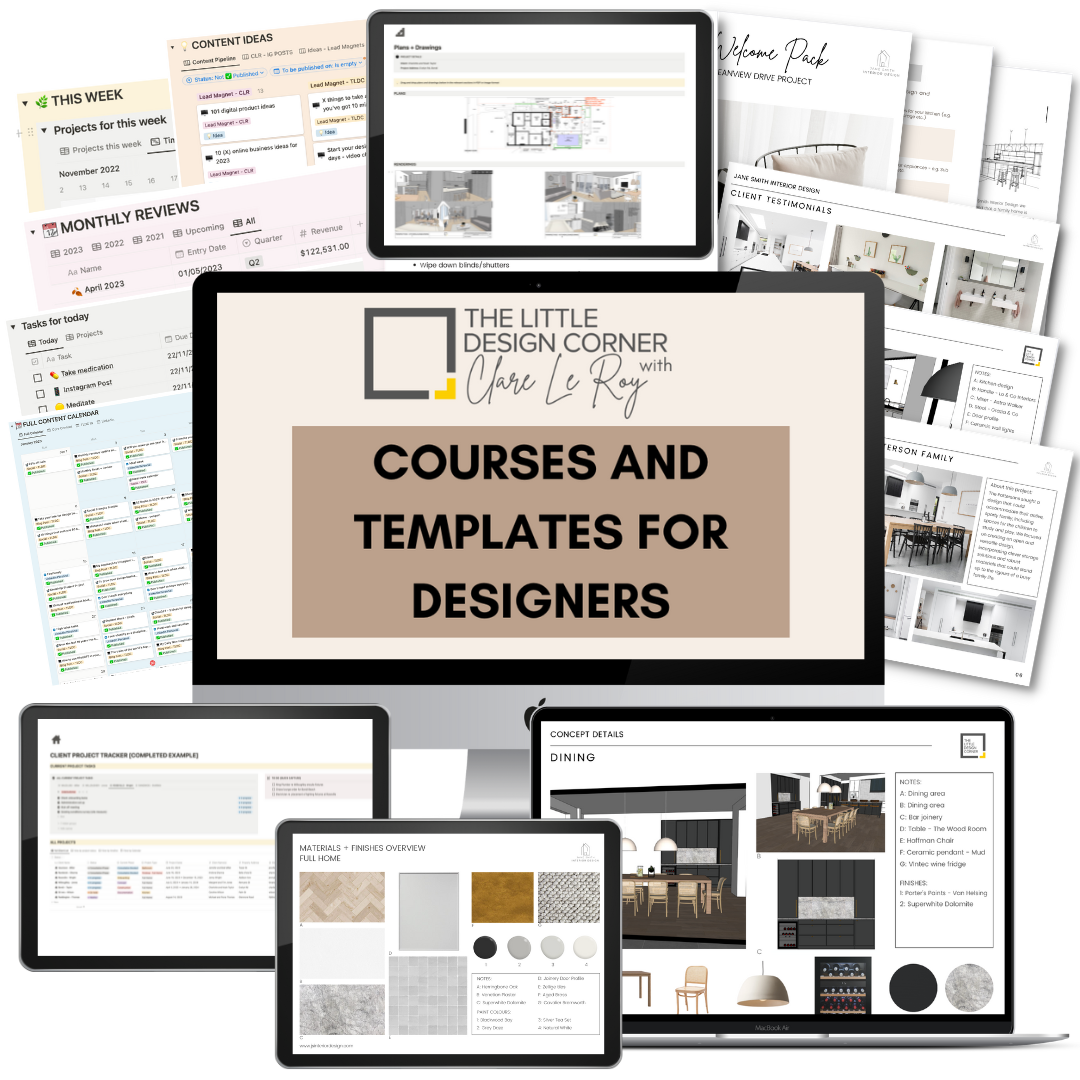How to improve your interior design business website
Your website is one of the most important assets in your business.
It’s where potential clients decide if they want to work with you and it plays a massive role in whether or not you’ll convert website visitors into paying clients.
Most interior designers build websites that focus way too much on themselves and not enough on their potential clients. Worse still, they build a website that they hope will impress other designers in the industry.
If your website is just a collection of beautiful portfolio images with an ‘About’ page and a contact form, you’re missing out on a huge opportunity. Your website isn’t just an online portfolio - it’s a sales tool. And if you want it to work for you, it needs to be designed with your ideal client in mind.
In this post, I’ll walk you through five key ways to improve your website so that it attracts the right people, keeps them engaged and ultimately helps you book more clients.
1. Make your website about your client, not about you!
One of the biggest mistakes I see designers make is creating websites that are all about them. Their homepage is filled with a bio, awards and a statement about how they love design. While all of that is great, it’s not what a potential client actually cares about.
Clients are visiting your website because they have a problem they need solved - e.g. designing their home. Your website needs to make it clear that you understand their needs, you work with other clients just like them and that because of this you’re the right person to help them.
✅ How to fix this:
Shift the focus of your content from “Look at my work” to “Here’s how I can help you.”
Make sure your services page outlines exactly what you offer, who it’s for and how people can work with you.
2. Have a clear, compelling homepage
You have less than five seconds to grab someone’s attention when they land on your website. If they don’t immediately understand what you do and who you help, they’re going to click away.
Too many design websites have vague statements or, worse, just a gallery of images with no explanation. This makes it hard for visitors to know if you’re the right fit for them.
✅ How to fix this:
Use a clear, concise statement on your homepage that explains what you do and who you serve.
A simple formula to follow: “We help [ideal client] achieve [desired outcome] through [your service].”
Example: “We help homeowners transform their spaces into elegant, livable homes with our full-service interior design process.”
So instead of leading with information about yourself, start with a clear statement about who you help and what you do. Another example: “We help busy families create beautiful, functional homes that make everyday life easier.”
3. Use multiple calls to action (CTAs)
Getting visitors to your website is hard enough, so once they’re there, you want to keep them engaged and guide them toward working with you. The problem? Many designers don’t give their visitors a clear next step.
If your website only has a contact form hidden on a separate page, you’re losing potential leads. People need clear directions on what they should do next.
✅ How to fix this:
Add clear calls to action (CTA) throughout your website so visitors know what to do next.
Use multiple CTAs throughout your website.
Examples of effective CTAs:
“Book a Free Consultation”
“Download Our Design Guide”
“How to start working together”
“Explore Our Services”
Make sure your CTAs are easy to find and stand out visually on your site.
4. Give people what they expect (Don’t overcomplicate things!)
Some designers try to be too creative with their websites, making it harder for visitors to find what they need. For example, calling a blog “The Notebook” or a services page “Your Journey” might sound unique, but it actually confuses potential clients.
Your website visitors expect to find things in certain places and with certain labels. If they can’t quickly find your services, contact information or process, they’ll leave.
✅ How to fix this:
Stick to standard website structure:
Home
About
Services
Portfolio
Blog/YouTube or your content pages
Contact
Make sure your navigation menu is clear and easy to use.
Avoid using overly clever names for your pages - call them what they are!
5. Add social proof to build trust
Clients want to feel confident that you’re the right designer for them. One of the best ways to build trust is by showing social proof - things like testimonials, media features, awards or client results.
Too many designers rely only on their portfolio to sell their services. But a portfolio alone doesn’t tell a potential client what it’s like to work with you or what results they can expect. Social proof helps bridge that gap.
✅ How to fix this:
Add testimonials from happy clients throughout your website (not just on a separate testimonials page).
Include screenshots of client feedback, emails or social media messages that highlight positive experiences. People won’t trust a testimonial that you’ve retyped into your website to make it look aesthetic - so use screenshots instead.
If you’ve been featured in the media, add a section with logos or links to those articles.
Show any awards or recognition you’ve received.
Make your website work for your business
Your website should be one of the hardest working assets in your business, helping you attract and convert the right clients. But too often, designers make it all about aesthetics and forget that a website is mainly a marketing tool.
To recap, here are the five key things you can do to improve your interior design website:
Make it about your client, not about you. Focus on their needs and problems.
Have a clear homepage statement. Let visitors know what you do and who you help immediately. Don’t make it hard for people to do business with you.
Use multiple CTAs. Guide people toward taking action.
Give people what they expect. Don’t make them think too hard - keep things clear and simple.
Add social proof. Build trust with testimonials, media mentions and client results.
By implementing these changes, you’ll create a website that not only looks great but also converts more visitors into clients.
Thanks for reading and catch you in my next post :)
Clare x
Dr Clare Le Roy
Courses and Templates for Designers and Architects
DO YOU WANT TO….
Find more clients?
Bring in more revenue?
Create better systems and processes?
Then check out my business courses and templates for designers and architects.
These courses and templates leave you with work done - not just a long list of things you need to do next. We have a really strong focus on taking action and getting things created that improve your business.








